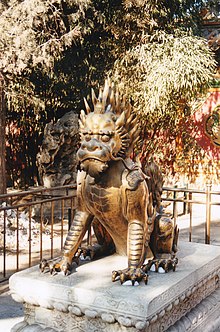Xiezhi

| Part of a series on |
| Chinese folk religion |
|---|
 |
|
|
The xiezhi (Chinese: 獬豸; pinyin: xièzhì) is a mythical Chinese creature found in various East Asian legends. It resembles an ox or goat, with thick dark fur covering its body, bright eyes, and a single long horn on its forehead. It has great intellect and understands human speech. The xiezhi possesses the innate ability to distinguish right from wrong, and when it finds corrupt officials, it will ram them with its horn and devour them. It is known as a symbol of justice.
History[]
According to the legend, Emperor Shun's minister Gao Yao had a mythical, goat-like creature called the zhi (廌) which he used in criminal proceedings whenever he was in doubt. The animal instinctively knew the innocent from the guilty; it butted the latter with its single horn.[1]
As a symbol of traditional Chinese law, XieZhi has been promoted by the Chinese Dynasties. Legend has it that during the Spring and Autumn Period and the Warring States Period, King Wen of Chu once obtained a XieZhi and put its image on his head, and then the Xiezhi crown became a fashion in the State of Chu. Law enforcement officials in the Qin Dynasty also wore such crown, as did the Han Dynasty, which inherited the Qin system. By the Eastern Han Dynasty, images on the XieZhi became an indispensable ornament in the Xie Men, and the XieZhi crown was titled on the law. Therefore, the law enforcement officials was called XieZhi. This kind of situation has continued forever.
Mentions of the xiezhi in Chinese literature can be traced back to the Han Dynasty where it is described by the scholar Yang Fu as a "righteous beast, which rams the wrongful party when it sees a fight and bites the wrongful party when it hears an argument". It is described in the Shuowen Jiezi as being "a cattle-like beast with one horn; in ancient times. It settled disputes by ramming the party at fault".
As an inherently just beast, the xiezhi was used as a symbol of justice and law. The Censorate of the Ming and Qing eras, who were responsible for the monitoring of the civil service, wore the xiezhi as a badge of office. Among the folk, the behavior of XieZhi to dispel evil spirits can be seen all over China, and people will also carve a XieZhi image on items such as locks to frighten off evil spirits. Similarly, military policemen of the Republic of China wear badges bearing the xiezhi and it is engraved on the gavels in the law courts of the People's Republic of China.
Similar to this is the symbol of Unicorn in the West.
In other places[]
Japan
In Japan, it is known as kaichi (獬豸), also sometimes referred to as a shin'yō (神羊, "divine sheep"). The kaichi is described as similar to a lion with one horn on the top of its head.[2]
Korea

The xiezhi is known as haetae (해태) in Korea. According to Korean records, Haetae's body is muscular and shaped like a lion and has a horn on its forehead. It has a bell in its neck and the body is covered with sharp scales. It lives in the frontier areas of Manchuria.[3]
In ancient Korea, Haetae sculptures were used in architecture during the early Joseon dynasty as their image was trusted to be able to protect Hanyang (now Seoul) from natural disasters and to give law and order among the populace. In Korea, haetae is a mythical beast that prevents fire disaster. To prevent fire in Gyeongbok palace, haetae sculpture was placed in front of the palace. Seoul city has officially used Haechi (origin of Haetae) as the symbol of Seoul since 2009.
In English, it is called "the unicorn-lion" or "an omniscient mythical beast".[citation needed]
Vietnam
In Vietnam it is known as giải trãi. [4]
See also[]
- Qilin
- pixiu
References[]
- ^ Jeannie Thomas Parker, The Mythic Chinese Unicorn, http://chinese-unicorn.com/ch01/
- ^ Gould, Charles (2009). Mythical Monsters. BiblioLife. pp. 357–359. ISBN 0-559-10836-2.
- ^ An Illustrated Guide to Korean Culture - 233 traditional key words by The National Academy of the Korean Language
- ^ Những thần thú trong tâm thức Việt - Kỳ 6: Giải trãi - linh thú được tôn sùng là thần công lý
External links[]
| Wikimedia Commons has media related to Xiezhi. |
- Chinese legendary creatures
- Korean legendary creatures
- Legendary mammals
